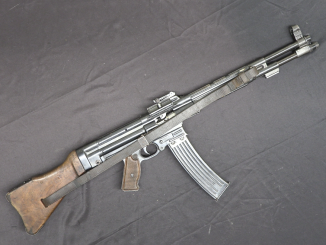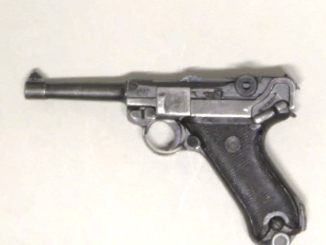This rifle failed to sell at Rock Island on December 1, 2018.
Introduced by a Dutchman in 1897, the Wehrmannsgewehr was a type of 3-position shooting competition using military pattern rifles in a sporting caliber (the 8x46R, firing roughly a 150 grain lead bullet at 1800 fps). It was pretty limited in popularity in Germany until the end of World War One, when the Treaty of Versailles prohibited Germans from owning military arms. At that point, the sporting-caliber Wehrmannsgewehr became a very handy loophole in the law as a way for men to practice shooting skills with military style rifles. It would become quite widespread especially in northern Germany until the 1930s, when rimfire shooting began to eclipse it (the .22 rimfire ammunition was a lot cheaper, the guns were promoted by the government, and the 50m rimfire ranges were much more common than the 300m ranges required for Wehrmannsgewehr matches. Examples of these rifles were both made brand new and also converted from existing Gewehr 98s; this is an example of a conversion made by Haenel. As is typical, it is a single-shot rifle, with the magazine left filled with wood and a new stock covering the magazine area.




I wonder why nobody actually thought that this sporting weapon could be used in wartime as an ambush gun. Just because it’s magazine doesn’t work doesn’t mean it isn’t a serious threat to anyone stupid enough to stare down the barrel. And how is it that the occupation authority didn’t notice the bayonet lug? If it can act as a spear, expect someone to use it that way! I could be wrong.
“8x46R, firing roughly a 150 grain lead bullet at 1800 fps”
Municion shows two very similar cartridges:
8×46.5 R Scheibengewehr http://municion.org/8/8x46_5R.htm
8×47 R MB Stahl http://municion.org/8/8x47rMbStahl.htm
First one is Austrian, introduced in 1876 and second German, introduced in 1880, so apparently it existed year before Wehrmannsgewehr was introduced in 1897.
Notice that rimmed natural and general shape of case suggest that cartridge is ill suited to be used in box-magazines as used in Gewehr 98.
“firing roughly a 150 grain lead bullet at 1800 fps”
This is more or less equal to .32-40 Ballard in smokeless iteration, as https://www.chuckhawks.com/32-40WCF.htm gives 165 grain jacketed soft point bullet at between 1800 and 1900 fps. Interestingly .32-40 had (in its time) reputation of being accurate, I presume that it must be true also for 8x46R as it was chosen several years for this competition after being introduced to market, so it probably already scored good reputation for accuracy.
“as an ambush gun. Just because it’s magazine doesn’t work doesn’t mean it isn’t a serious threat to anyone stupid enough to stare down the barrel.”
Moreover, as it fire de facto target cartridge this mean there should be not problem with finding, what would be today called match grade ammunition.
” this sporting weapon could be used in wartime”
Citing H.L.Mencken For every complex problem there is an answer that is clear, simple, and wrong.. In this case “military cartridges are verboten” indeed solves problem of such cartridges, but it is still possible to use cartridges like 7×64, 8×60-Magnum-Bombe or 8×64 S, which actually were superior ballistic wise to original 7,9×57 cartridge.
is: “(…)7,9×57 cartridge.”
should be: “(…)7,9×57 cartridge and could be used in Gewehr 98 after its modification.”
I don’t know if the 9.3×64 would be relevant to this list, not being able to compare its easiness of use to the previously mentioned.
I did not mention 9,3×64 as it was introduced in 1927, while 8×60 was introduced in 1919 and 8×64 S and 7×64 are actually pre-war development, so these three were available in immediate post-war era.
Thank you for the complementary information
Sure it can be used in wartime, but if you put it in the hands of a million civilians you have 1870’s technology fighting soldiers with 1920’s technology. Same for the bayonet. In short no one was sweating the small stuff. This was about protecting national interests from Germany, not individual incidents occurring in Germany. Even in heavy gun control countries single shot weapons capable of killing people are generally still permitted.
How many soldiers of the Allied occupation force wanted armed conflict with the locals in 1920’s Germany? Not many, unless they were heartless enough to order artillery barrages to OBLITERATE every village confirmed to have even ONE obsolete rifle lying around. The Allied authorities were admittedly quite lazy and accepted reports declaring most military grade weapons destroyed (the best rifles and machine guns were actually hidden in private cellars, ready to pop out when needed). To them, obsolete target rifles were harmless as a prankster’s slingshot. The black-powder target rifle isn’t harmless if used to window-snipe some stuffy occupation officer down the street. That’s the kind of fear I thought the Allies would have, that their troops could be massacred at any moment in any given town by angry civilian mobs!
Please consider that millions of -now declared illegal- rifles still existed in Germany after WW1. The Inter-Allied Military Control Commission agreed to the creation of the 8 x 60 cartridge as a means to de-militarize 7.9 mm (8 x 57) rifles owned by civilians by re-chambering the barrel.
I view of this, I see the danger from single-shot low-power blackpowder target rifles firing lead bullets as quite limited.
By the way, most Wehrmann shooting was at 175 m.
Ian, I do not understand how a Dutchman would be that much interested in the shooting sports in Germany to be involved to this extent – and why Germans would let someone from the Netherlands run with this concept in their country?
I don’t see anywhere in the article or video where it is said that a Dutchman imposed this on Germany. According to the article and video it was just a style of shooting introduced by a Dutchman in Holland that spread marginally to especially northern Germany but with an increase in interest with the limitations of Versailles for military style shooting as there were no longer military weapons available for civilian marksmanship. German manufacturers needed product to stimulate their economy and this was one of many different ways to do that. The German people were still significantly militaristic after WWI, they thought they had been betrayed internally rather than defeated in the field, and with only a 100,000 man Army no German government wanted to have a castrated male population that might be needed to back up this tiny army. What a difference with the German people’s anti-militarism after WWII when Germany had been ground down into nearly dust.
I recently acquired one of these rifles and it is very pleasant to shoot. Cartridge cases are available from RWS, Bullets from H&N and (in the USA) from Buffalo Arms – who also do bullet moulds.
I am curious about the strange nonstandard front band. Can someone illuminate?
Ian,
the Wehrmannsgewehr was manufactured and used during the Weimar Republic. Its flag was “schwarz – rot – gold” (black – red – gold) like todays German flag — not the “schwarz – weiß – rot” (black – white – red) of Prussia and the Imperial Kaiserreich which you use in the title of the clip.
Hello, Mr. McCollum,
I’ve at home in Germany beside 3 other each different Wehrmanngewehre 8,15×46 R exactly such a Haenel-Lorenz, #561.
I’ve the strong feeling, that this pattern was never a former military service-rifle. They were new produced between the end of WW1 and sometimes around the mid-1930s.
To proof that: the bolt is a not standard service-production, it has a short extractor. The gun has no magazine constructed at, the stock and the triggerguard-assembly is different and the upper band and the bolt-stop are also different. Additionally there is no military control- or proofmark or numeration visible on which part whatsoever,as it was common on every German/prussian firearm. And of course the new barrell in 8,15x46R.
If you have to overwork a former military-repeater GEW 98 to become somewhat like the Haenel-Lorenz Serviceman single-loader, its surely easier and less expensive to build a brand new gun.
Being currently in Washington I don’t have the rifle present at the moment. My collection at home, only Mauser-military-rifles, is, I would say, not small.
Forgotten weapons is a perfect place to learn, so did I, even after being an advanced collector since 1/2 century…… please, go on…..